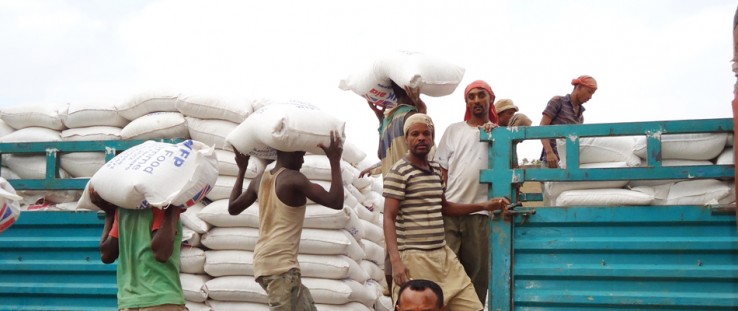 Members of the Sidama Elto Farmers Cooperative Union deliver 120 metric tons of maize to WFP Purchase for Progress program.
USAID/AGP-AMDe
Members of the Sidama Elto Farmers Cooperative Union deliver 120 metric tons of maize to WFP Purchase for Progress program.
USAID/AGP-AMDe
 Members of the Sidama Elto Farmers Cooperative Union deliver 120 metric tons of maize to WFP Purchase for Progress program.
USAID/AGP-AMDe
Members of the Sidama Elto Farmers Cooperative Union deliver 120 metric tons of maize to WFP Purchase for Progress program.
USAID/AGP-AMDe
In Ethiopia, smallholder farmers grow 94 percent of that country’s maize—a crop deemed crucial to Ethiopian food security. Maize has tremendous income-generating potential in Ethiopia, but only half of the country’s farmers grow maize as a cash crop. Most smallholders lack the critical access to finance, improved inputs and markets that are required to transition from subsistence farming to commercial maize production and marketing. However, with USAID support under Feed the Future, the U.S. Government’s global hunger and food security initiative, this transition is becoming a reality for more than 30,000 smallholder farmers.
Late last year, the U.N. World Food Program (WFP) agreed to buy more than 28,000 metric tons of white maize, worth approximately $10 million, from 16 of Ethiopia’s farmer cooperative unions for its relief efforts in several chronically food insecure districts. With USAID support under Feed the Future, seven of the cooperative unions signed contracts to deliver 16,000 metric tons. The remaining nine unions received support from other donors.
The deal brings together USAID, WFP, the U.K.’s Department for International Development, and the Ethiopian Agricultural Transformation Agency and Ministry of Agriculture. This marks the first time the WFP’s food purchase program will directly source maize from Ethiopian farmer’s cooperatives. The initiative builds on WFP’s existing local purchase program, which last year purchased more than 100,000 metric tons globally from commercial farms and traders, for distribution mostly in Ethiopia.
“Through USAID support in Ethiopia, President Obama’s Feed the Future initiative is leveraging hundreds of millions of dollars of other donor, government and private sector resources to help Ethiopia take steps to reduce its dependence on food aid,” said USAID/Ethiopia Mission Director Dennis Weller. “The sales to WFP are a promising start for Ethiopia’s relatively more productive farmers in the food secure districts to sell surpluses to benefit not only themselves, but the residents of food insecure areas.”
The 28,000 metric tons of maize will be distributed to relief operations in Ethiopia’s Amhara; Oromia; and Southern Nations, Nationalities and Peoples regions. According to Abdou Dieng, WFP country director for Ethiopia, “WFP’s aim in increasing purchases with local farmers is to help them to increase their income by connecting them to bigger markets.”
The strategy is at the heart of Feed the Future’s broader goals, according to Julie Howard, chief scientist in USAID’s Bureau for Food Security. “That’s fundamentally what Feed the Future is,” she said. “It’s looking at how to empower local farmers, local communities to improve their production … to advance economic transformation in these countries.”
For farmers belonging to the seven USAID-supported cooperative unions, including the 36,000-member Gibe Didhessa cooperative in the Oromia Region, the new purchase agreement provides a buffer to market price fluctuations.
“The price of maize has been declining owing to the shortage of financial capital among the local traders,” said Sileshi Angarssa, general manager of the cooperative, who received training about maize marketing from USAID. “More importantly, maize is a very perishable cereal with a relatively short shelf-life. Hence, the farmers would have been forced to sell their produce at a lower price if it was not for the WFP program purchase agreement that USAID helped us to arrange.”
Breaking the Famine Cycle
For several decades, Ethiopia has depended on international food aid when faced with recurring drought. After a severe drought in 2003, taking the lives of tens of thousands of Ethiopian children, the Government of Ethiopia, in partnership with USAID and the international community, attempted to tackle the underlying causes of vulnerability.
As a result of the Productive Safety Net Program (PSNP), established in the aftermath of the 2003 drought, the resilience and community assets of hundreds of thousands of Ethiopians has increased, reducing their vulnerability to these types of shocks. Besides helping set up the safety net program, USAID has provided Ethiopia with more than $1.2 billion of support, primarily for emergency food aid, over the past decade.
The drought in the Horn of Africa in 2011 demonstrated that Ethiopia’s safety net program is working. Although some say the 2011 drought was as bad as 2003, there were far fewer deaths and fewer Ethiopians required emergency assistance than many expected thanks to the systems USAID helped to develop.
Meanwhile, the Government of Ethiopia began to invest significantly in agriculture and infrastructure. The economy has experienced an economic revival, with GDP growth at 7.3 percent in 2011, well above the average seen across sub-Saharan Africa. While the threat of famine has not been removed, enough progress has been made that USAID/Ethiopia, under Feed the Future, is now working to help support smallholder farmers located in relatively more productive areas to market excess production.
The nature of USAID’s programs in Ethiopia is evolving along with the country’s recent growth. According to Weller, “the new Feed the Future resources have enabled USAID to help Ethiopia accelerate along its development path to improved food security and greater economic growth. While we continue to help strengthen the government’s systems to respond to reoccurring drought, we are also now helping the country to increase its overall productivity.”
Bulking Up Sales, Trade, Marketing
The WFP partnership builds on these gains and aligns with the Government of Ethiopia’s broader agricultural goals to strengthen the maize value chain. However, to meet the quality and quantity standards required for farmers to sell to WFP, a number of challenges must be addressed.
Maize production in Ethiopia remains far below its potential due to the limited use of improved seeds, fertilizers and knowledge about best farming practices. In addition, Ethiopia’s smallholders experience between 15 percent and 20 percent post-harvest losses due to pest infestation and poor storage and handling. An added threat caused by improper post-harvest handling is aflatoxin—a highly toxic mold that presents serious food safety concerns.
To address these challenges, Feed the Future supports cooperative unions, and government and private sector partners to improve smallholder farmers’ access to finance that, in turn, improves yields and crop quality, and reduces post-harvest losses. For example, USAID has negotiated with Ethiopian banks to develop a means for farmers and cooperatives to use agricultural contracts as collateral for loans to purchase fertilizer and seed instead of more traditional assets like real property, which farmers often lack. USAID’s technical assistance also includes support to the cooperative unions to develop new systems for maize cleaning, grading and packing to meet quality and health safety standards and agreed upon delivery schedules.
New Opportunities Seeded
Today, the seven USAID-assisted farmer cooperative unions are better able to deliver large-scale quality maize supply to buyers like WFP. As of mid-April 2013, more than 65 percent of the 16,000 metric tons had been purchased and aggregated by the unions for delivery to WFP with the remaining balance expected by the end of May 2013.
Tesfaye Kibret, a farmer and cooperative member in the relatively food-secure Abesheti district, sold 12 metric tons of maize to the WFP program for $260 per ton. This is a good price for maize, especially early in the harvest period. In previous years, he would have had to wait much longer to sell his product and at a lower price in the small local market.
“I hope the cooperative union agrees to a larger maize commitment next year because I would like to sell even more maize,” said Kibret.
Weller recognizes the potential of this kind of partnership. “These results show that in the right conditions, large numbers of smallholder farmers, through their cooperative unions in relatively more productive food secure areas of Ethiopia, have the potential to meet the high quality and quantity of large buyers and help improve food security in Ethiopia, he said.
Ethiopia’s leading financial institutions are recognizing the cooperative unions’ potential as well. Maize suppliers had been unable to obtain loans to expand their farms because they were not viewed as business enterprises. This year, with technical assistance from Feed the Future through USAID, several maize cooperative unions secured loans from the Commercial Bank of Ethiopia. On average, the unions received about $310,000 each under the new loan agreements.
“These first few loans serve as significant steps forward in helping smallholder farmers obtain the trust of financial institutions to invest in the maize sector,” said Weller.
Sisay Yohannes, general manager of the 9,000 member Sidama Elito cooperative union, is also thinking about the future and maize’s income potential.
“This year, the market opportunity created through WFP has solved almost all of our previous problems,” he said. Noting that seasonal oversupply and rising input prices are squeezing farmers’ income potential, Yohannes added that, “the farmers and the cooperatives have benefited tremendously from the WFP program, which may expand next year. These types of future sales agreements are motivating farmers and cooperative unions to increase production and improve the quality of their maize for next year.”
This experience is also critical for helping cooperative unions to qualify for large commercial contracts with agro-processors. Such food processors have the potential to buy more quantities of maize than WFP in the future as the country’s population continues to grow.
USAID’s Howard hopes that the work done with these 30,000 Ethiopian farmers and their cooperative unions foreshadows larger systemic changes.
“Since three-quarters of the world’s poor live in rural areas, we’re really not going to get them out of poverty unless you transform agricultural systems … to create jobs, to create more income, to allow people to send their children to school. So it really requires this focus on agriculture,” says Howard.
Alex Pavlovic manages strategic partnerships with USAID’s Agribusiness and Market Development project.







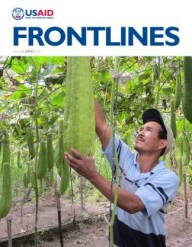

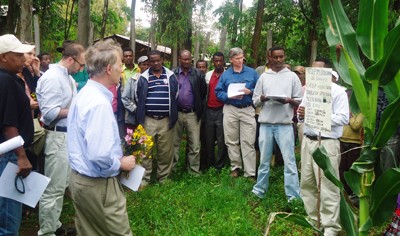
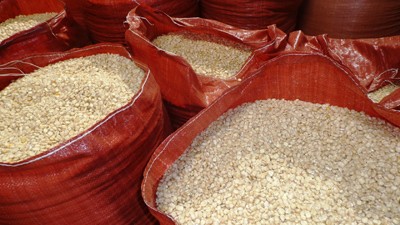
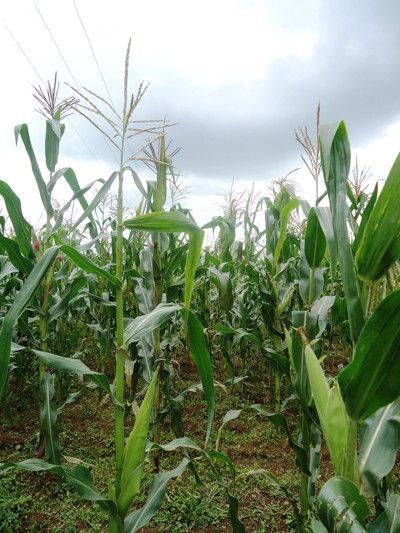
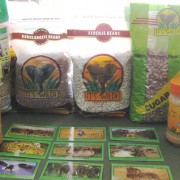


Comment
Make a general inquiry or suggest an improvement.